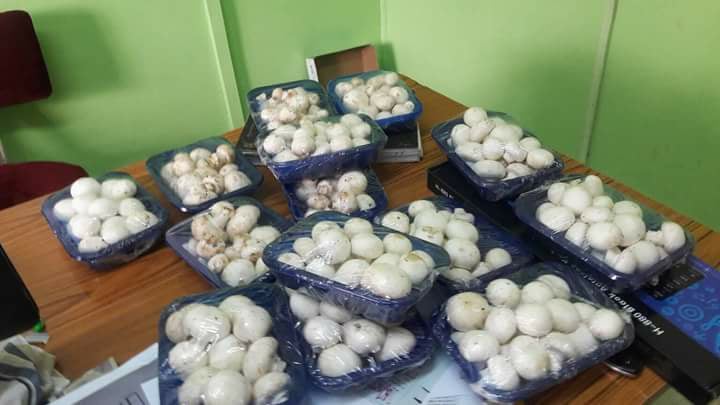One farming area that is less populated is mushroom farming especially oyster mushroom. The demand for mushroom is at an all time high with most retail shops running out of the agricultural produce. Interested in giving it a try? Then research more about it especially how to grow it and accessing markets.
Below we feature an article from one of Zimbabwe’s leading agriculture experts, Mr Philemon Buruzi.
Growing Oyster Mushrooms
Despite the fact that oyster mushrooms are relatively new on the Zimbabwean food market, they are fast becoming a favourite of many customers countrywide. Oyster mushroom cultivation is the simplest and least cost when compared to other types of mushrooms. This is so because oyster requires no special inputs but rather can be grown using locally available materials and even makes use of agricultural waste. The only requirement that a prospective mushroom grower needs to outsource apart from the mushroom spawn is know how and that is what I endeavour to provide by putting together this article.
Definitions
Terms used in mushroom growing which might be new to the uninitiated are given below;
Spawn – this is the mushroom ‘seeds’,
Spawning – refers to the process of ‘planting’ the mushroom,
Substrate – is the agricultural waste on which the mushroom grows e.g wheat straw,
Fruiting – formation of the mushrooms under specific house conditions.
Required Facilities and Equipment
Fruiting house, spawning house, spawn, thermometer, hygrometer, water sprayer, buckets, plastic bags, sterilising drum, string
Spawn and Substrates
Spawn is purchased from spawn laboratories. Substrates can be any of the following materials-sawdust from deciduous trees, banana leaves, cotton waste, milled maize cobs, chopped rice or wheat straw, chopped maize stalks. Ensure that the substrate has high nutrient content, good water-holding capacity and is well aerated. To control acidity, add 2% lime by weight and 20% wheat bran to improve quality.
Spawning Room
After spawning, substrate bags are kept in this room for development of the mycelium. This room should provide dark conditions and a temperature of around 240C. Alternative the same mushroom house can be used provided it can be made dark as required during incubation.
Fruiting House
This is the room in which the mushroom grows. The size of this room depends on the scale that the grower wants to operate at. The walls of the room can be made of any material be it bricks, wood, thatch or even pole and dagga. It is recommended to line the walls with plastic sheeting in order to relative manage humidity better. Ventilation should be adequate, hence air vents or windows need be in place. The room should have enough light as and when needed. Wooden shelves or racks should be fitted to handle spawned substrate bags. The house should provide for temperature maintenance between 180C-250 C and humidity of 80-90%.
How to do it
Below is a four stage process of growing oyster mushroom presented in a step by step format;
Step One – Substrate preparation
Chopped or shredded substrate is soaked in water overnight. After 24 hours excess water is drained off and lime is added. Transfer the mixture into the sterilising drum and subsequently filled with hot water. The drum is allowed to boil for 60 minutes before transferring the substrate onto a plastic sheet to cool off to between 38-400C.
Step Two- Spawning
Pack the substrate into transparent plastic bags adding the spawn even layer upon layer. Care should be taken not to pack the substrate too tightly or too loosely. Also ensure that this stage takes place under hygienic conditions as diseases tend to enter at this phase. Tie the open end of the plastic bag immediately after filling.
Step Three- Incubation
Place the spawned bags in dark room at 240C or simply cover the bags with black plastic sheets. Incubation lasts between 14-40 days and full colonisation is evidenced by white mycelium covering the whole bag.
Step Four- Fruiting
Initiate the formation of the mushroom bodies by exposing the bags to light. Once light hits the bags fruiting commences. After 24 hrs make long cuts at the top and bottom of the bags. Mushrooms will start to form in 4 days. Temperature should be maintained between 20-280C whilst humidity is between 80-95%.
Step Five-Harvesting
Mushroom are ready to be plucked 4 days after the emergence of the fruiting body. handle by the stalk twist gently and pull out. Harvesting is best done in the cooler hours of the day. Immediately refrigerate without freezing to preserve freshness. Make more long cuts around the centre of the bag for more mushrooms to emerge. Continue to harvest till the substrate turns colourless and of a soft feel. In general terms 10kg of substrate should give you a yield of between 10kg-20kg of mushrooms.
For all questions and comments: philemonburuzi@gmail.com.
![]()





